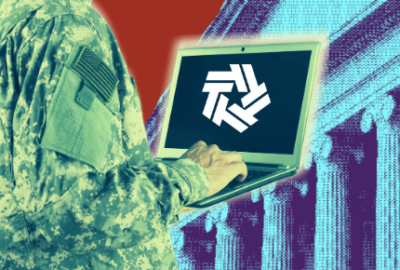
FirstNet adds 5G to first responder network as part of AT&T contract, expanding rural broadband
Four years in, the FirstNet program is adding 5G technology to the nation's first responder network. And it's been steadily building out coverage in rural parts of...
Best listening experience is on Chrome, Firefox or Safari. Subscribe to Federal Drive’s daily audio interviews on Apple Podcasts or PodcastOne.
Four years in, the FirstNet program is adding 5G technology to the nation’s first responder network. And it’s been steadily building out coverage in rural parts of the country. Here with a progress report on the fourth anniversary of its contract with AT&T, the CEO of the FirstNet Authority, Ed Parkinson, spoke to Federal Drive with Tom Temin.
Interview transcript:
Tom Temin: Ed, good to have you on.
Ed Parkinson: Hey Tom, good morning. Great to see you.
Tom Temin: Let’s talk about the build out to rural areas, because in many ways, it’s the lack of connectivity and coverage in rural areas. That’s been a bugaboo of first responders outside of the city. So how does the map look now in terms of 3, 4, even 5G coverage versus what it looked like four years ago?
Ed Parkinson: Rural is a key part of the program. One of the key aspects of the legislation talks about significant rural milestones at every year in every phase of the deployment. We built that into our contract with AT&T, we currently now cover 30 million more Americans than what originally happened at the beginning of the contract. And that’s, I think, one of the great aspects of this program that not too many people know about, we are a dedicated Public Safety Network. And so we’re able to provide that dedicated, always on priority and preemptive service. But a great offshoot of the program, as Americans are able to take advantage of the network build for non-public safety use when public safety don’t need that spectrum. And today, four years after we signed the contract with AT&T, 30 million Americans now can enjoy broadband services in rural parts of the country that they didn’t have that service four years ago. So all in all, we’ve made a lot of progress, we’ve got a long way to go. But it’s a really, really important milestone.
Tom Temin: So those areas that now have this new coverage then anyone can use that bandwidth, but there’s the preemptive capability for law enforcement, first responders in time of need.
Ed Parkinson: Exactly right. And we’ve seen new sites go online and rural communities just in the last few months in New York, North Carolina, Oklahoma and across the nation. We’re live in every state. And it’s amazing to see how we’ve been able to partner with rural carriers. I think that’s a key component of this, the contract allows for AT&T to partner. And I think, a good example, in one rural providers adding band 14 spectrum to hundreds of cellular sites across rural Colorado and Nebraska, as well as parts of South Dakota and Wyoming. So that I think shows the ingenuity of the contract. And that was something we felt was important to take in four years ago.
Tom Temin: So to add that coverage, then AT&T might be linking with carriers that are already extant there. That is to say they didn’t have to build towers to cover 30 million new people.
Ed Parkinson: That’s I think part of the power of this public private partnership, there are some new site builds, of course, there’s new steel as it’s called. And that is providing new service in areas that there was zero service. But existing infrastructure as a key component of the legislation, we have to partner with rural carriers so that we could bring the power of Band 14, bring the power of FirstNet network to the rural communities. And we can see that too, with the expansion of our deployable fleet. That’s another aspect and another tool that we have in our toolbox. We have 72 satellite trucks. We’ve got three drones, we also have a blimp that was deployed last summer during the hurricanes in Cameron, Louisiana. And so these can provide that type of service in the underserved as well as damaged areas of networks where it’s being reconstituted. So again, building that redundancy, as well as that always on priority and preemptive service has been a key component of what we try to bring to public safety around the country.
Tom Temin: So the blimp and the drones actually can provide cellular service.
Ed Parkinson: It’s pretty amazing. The FirstNet One Blimp, it’s tethered, it goes up to about 1,000 feet, and think of as a mini Goodyear Blimp, right, that you see flying over football stadiums. But it’s being used and the service and the propagation we saw down in Louisiana in the wake of those devastating hurricanes last summer was very impressive. We learned a lot of terrific lessons, you got to watch out for wind speed, of course, when you’ve got something like that. But yes, that and then the drones that we’ve been able to put up and leverage. So what is exciting is we’re seeing new technologies, we’re seeing existing technologies, but we’re seeing the power of the marketplace come to public safety’s aid. And that didn’t happen before FirstNet came along four years ago. So it’s very exciting.
Tom Temin: And we should point out the FirstNet Authority is a unit of the Commerce Department whose main job then is to oversee that contract with AT&T.
Ed Parkinson: That’s absolutely right. We’ve got surely over 200 people in the FirstNet Authority covering contract experts, public safety individuals who are spread throughout the country who engaged directly with public safety. We’ve got a terrific team of folks, super nuts, and we’ve got great working relationships with one of our parent agencies. NTI. We’re an independent entity inside the Department of Commerce. And we’ve been very, very fortunate to have terrific working relationships across the board with DOC and with other federal agencies. And the federal agencies are key components of where we see adoption moving. You may remember just late last year, the FBI signed a big contract to sign up with FirstNet. And so we’re extremely honored and privileged to be able to provide those types of services to other federal users.
Tom Temin: And of course, 5G is the technology on everybody’s lips nowadays, you can’t watch television for three minutes without seeing a 5G ad. And my own phone says 5G sometimes on it, I don’t know what I’m getting out of it, but it says it on there. And that what is the 5G’s progress so far? What does it look like for the FirstNet network?
Ed Parkinson: We’ve always talked about being fast followers. Public safety has to rely and know the technology that they’re using is one that they can trust with their lives. That’s the standard that we had FirstNet use, and so understanding what is happening in the commercial marketplace, and being fast followers to where the commercial trends are going has been a strategy that we’ve used at FirstNet. And so adopting the AT&T millimeter wave spectrum that’s out there right now, and is being leveraged by public safety and 38 cities, as well as 20 additional venues across the country has been very exciting development. We made our first investments last summer into upgrading our core, so that it’s going to be 5G ready. And so was taking those necessary steps that will ensure public safety on the FirstNet network has 5G when they need it.
Tom Temin: Okay. And do you also track the usage of the network as it exists at a given moment? And what are the trends there in terms of bandwidth used or numbers of users that are given time? Because, say, if you get something like the FBI signing on, you probably can see that manifest in the meters of who’s using the FirstNet network?
Ed Parkinson: Oh, it’s a great question, Tom, I think what the important stat to remember here is our Band 14 spectrum as well as the entire suite of LTE spectrum., and now the 5G millimeter wave spectrum and hopefully more coming to FirstNet in the future — that pipe through which all that data traffic flows, that is just an enormous pipe that public safety always has that HOV lane fast-pass ticket to the front of the line. And so they’re never going to struggle. in terms of priority and preemptive, we saw that across the country just a few weeks ago, when that tragedy occurred out in Boulder, Colorado. Some folks who are using the FirstNet system out there really did talk about how they had absolutely zero service interruption, whereas commercial networks really did struggle. So I think that’s just a real hand example in a terrible situation of where public safety always can rely on trust that the FirstNet system is going to be there for them when they need it most.
Tom Temin: And if you’re on Band 14, which is I guess associated with 3G technology and LTE is 4G, if I’m correct here, the bulk of the use at this point is voice?
Ed Parkinson: Well, it’s data really, and voice is really just an application, isn’t it. So the Band 14 is LTE spectrum, and in time will be will be upgraded. But it really provides that foundation to the system. And I think that’s an important part any sort of legacy network that’s moving into a 5G ecosystem, 4G and 5G will interact. In the past when you went from 2G to 3G, that was a clean break, 3G to 4G, same thing. 4G to 5G, you’re gonna see really a staggering of the technologies. And I think what that provides, frankly, is that foundational baseline upon which FirstNet provides this terrific service, and one that we’ve got now over 2 million subscribers and 2 million people can’t be wrong, I suppose.
Tom Temin: And so yeah, that you reminded us that this is not a radio type of system but it really is digital all the way with voice itself being digital, when it passes over the net
Ed Parkinson: Right. And I always use the example of think about how one use the internet 10 years ago, think about how you use your phone 10 years ago versus today. Think about where it’s going to be two years or three years time, it’s going to be amazing to see how public safety is going to take advantage of things that have technology that you and I and children today don’t even think twice about. I have a four year old daughter, she knows how to skip an ad on YouTube video. I don’t know if that’s example of a bad parenting on my behalf. But it just shows how it’s going to be built into the psyche of the up and coming in the next generation of public safety users. And that’s at the federal, state and local level. So seeing the technologies of commercial use that we all enjoy today coming into the hands of public safety is a very exciting phase and 5G is going to open up so many doors that we can’t even imagine. So it’s an exciting time.
Tom Temin: Ed Parkinson is CEO of the FirstNet Authority. Thanks so much for joining me.
Ed Parkinson: Appreciate it, Tom. Thanks for time, all the very best.
Copyright © 2025 Federal News Network. All rights reserved. This website is not intended for users located within the European Economic Area.
Tom Temin is host of the Federal Drive and has been providing insight on federal technology and management issues for more than 30 years.
Follow @tteminWFED




